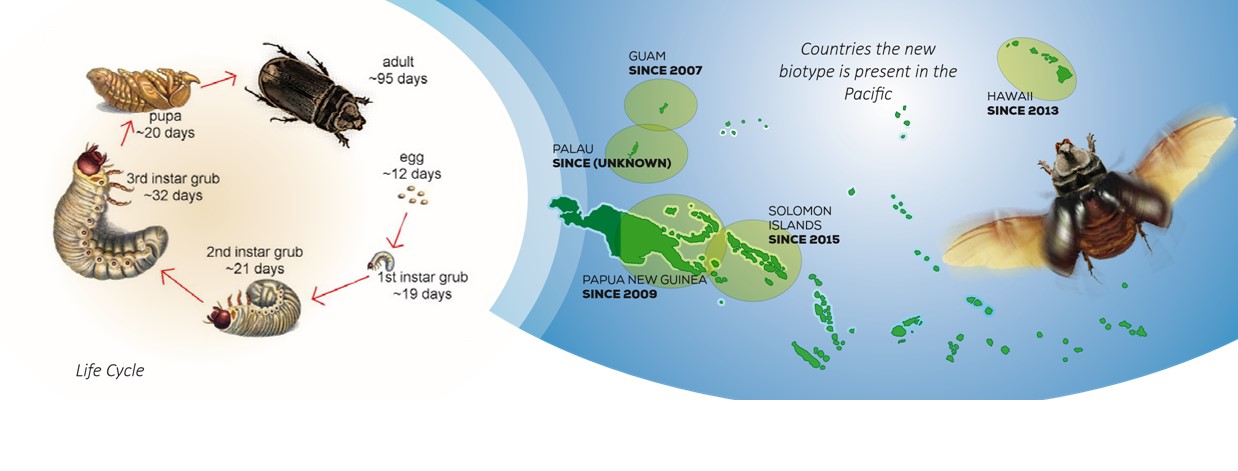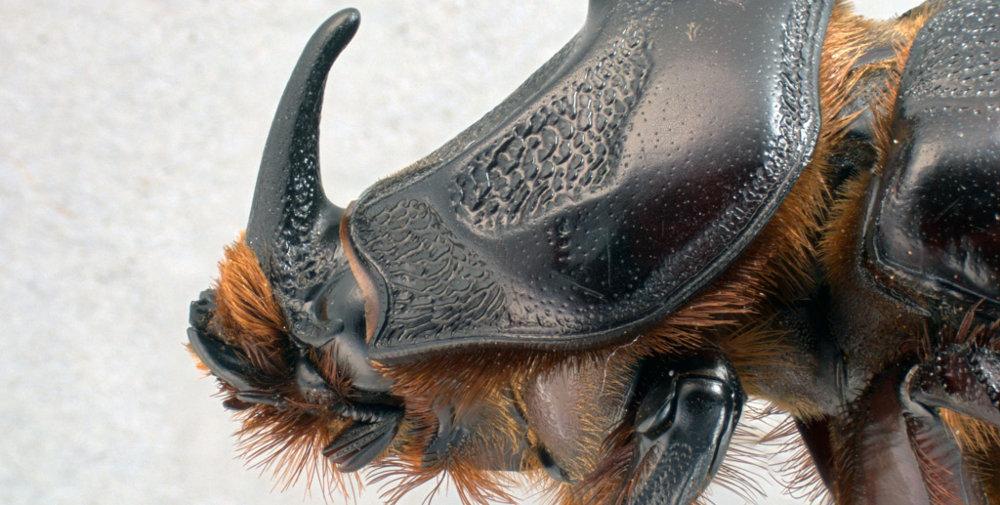Photo: courtecy of Durham Field Office – US Forest Health Protection
Ask someone to describe the Pacific and inevitably they will think of the coconut palms that decorate every Island nation. But the palms are more than providers of shade and backdrops for postcards; they are a central part of the region’s economy, and their health is essential to the continued prosperity of Pacific people. Recently, however, the health of coconut palms has come under severe threat. The Pacific Community (SPC), working with Pacific Island countries and territories, and development partners, is looking for ways to meet this threat before it devastates the hopes of economic progress in the region.
A thriving industry
The coconut industry has always been a centrepiece of economic activity in the Pacific; but since 1993, it has been rapidly expanding and diversifying. In 2016, the Coconut Industry Development for the Pacific (CIDP) initiative recorded 64 coconut-related businesses driving economic progress in the Pacific – a 50 per cent increase since 1993. More impressively, 25 of these products are sourced, created and distributed by Pacific-owned and Pacific-based businesses. These products –coconut milk, coconut vinegar, coco coir fibre, coco jam and bio fuel –are found on shelves of supermarkets around the globe. Combine that with the coconut palms’ contribution towards tourism and culture, and the importance of this resource becomes clear.
The industry is still expanding. CIDP has projected a 149 per cent increase in thecoconut water market alone between 2013 and 2018. The foundation is set for the coconut industry to play an integral role in the Pacific’s development targets for the foreseeable future, so long as the health and sustainably of the coconut palms remains secure.
The rhinoceros beetle arrives
In August of 2017 an alert was issued identifying a new danger to the Pacific, which is causing devastation to coconut palms and expanding rapidly across the region. The new threat comes from a longstanding adversary in the region: the rhinoceros beetle.
The first Pacific invasion of the rhinoceros (rhino) beetle took place in 1909. Originally native only to South Asia, the beetle was able to expand along the trade routes of the rubber industry, slowly establishing itself across South East Asia and into the Pacific. The Pacific coconut rhinoceros beetle (CRB-Pacific), had an appetite for coconut palms, and its arrival in the region resulted in many innovative control methods being tested. The most successful of these methods came from the discovery of the Oryctes nudivirus (OrNV), which proved deadly for CRB-Pacific. The virus was introduced as a control method in 1964, and as a result, for the next 40 years the CRB-Pacific was not a major a threat to the region.
However, in 2007 the rhino beetle struck back. A new biotype of the beetle appeared in Guam, which was resistant to the virus. Dubbed CRB-G, the beetle migrated quickly, with infestations being reported in the Papua New Guinea (PNG) mainland (2009), Hawaii (2014), Palau (2014) and Solomon Islands (2015). CRB-G has the ability to destroy an island’s entire palm population within one year, earning it the regional nickname of ‘Palm Killer’.

In 2017, a regional pest alert was issued to raise awareness about the new biotype. Following this, SPC’s Land Resources Division organised the CRB-G Workshop, bringing together scientific leaders from across the Pacific to share experiences in dealing with the CRB-G threat, and to determine how to best coordinate efforts.
Countering the threat
At the workshop, held in Fiji, Sean Marshall, an insect pathologist and molecular biologist at AgResearch in New Zealand, warned that despite the success of viruses as a control method for other rhinoceros beetle types, they may not be the solution for the CRB-G. “Virus development is not a silver bullet, it is only one of the tools to eradicate rhino beetles in our tool box, Marshal explained. “We have tested current isolates and distributed them throughout the Pacific as biological control agents, but none have worked on CRB-G.”
Marshall suggested that any hope of developing an effective virus to eradicate CRB-G would depend onlocating the origins of the beetle. “If we could identify the origins of CRB-G, we could go to that place and start examining what natural control agents are keeping it under control. Then we could attempt to bring these to the Pacific,” said Marshall.
Roland Quitugua, from the College of Natural & Applied Sciences at the University of Guam, suggested tekken netting traps as an alternative control method. These traps – created with tekken netting used by local Guam fisherman – are used to catch rhino beetles entering compost piles, and have been deployed in Guam with positive results. Quitugua said the idea came from Hawaii, where locals were observed using bird nettings to cover compost piles –a breeding site for CRB-G rhinoceros beetle – to catch the new biotype. A number of nets were then tested in Guam, with the tekken netting showing the best success rate. “Probably what is so great about tekken netting is its ease of application. For less than twenty dollars, a home owner can mitigate their risk of rhinoceros beetles,” he said.

Using traps
A variety of trapping methods have been used across the Pacific region to help control the spread of the coconut rhinoceros beetle. Follow the link below for an overview of some of the most common trapping tools:
Trapping Methods - Coconut Rhinoceros Beetle
According to Quitugua, over 15 km of the netting has already been deployed, for locals to use on their compost piles as traps. The key to the success of the community outreach in Guam has been a focus on saving the palms rather than destroying the beetle.
However, tekken netting alone will not be enough to stop the spread of the beetle. The consensus among all beetle experts is that a combination of tools is needed, and that each region must find their own combination of control methods to ensure that the rhino beetle does not destroy palms across the region.
The most important step however, is for SPC to recognise the problem and to take definitive action. The rhino beetle’s greatest ally is time, and the longer it takes to respond to the new invasion, the greater the threat will be. As Quitugua noted, “One of the biggest problems we had on Guam was that it basically took about two years before we could start up an eradication programme. That’s two years too late”.
With a clear need for quick action, ACIAR announced that it would commit AUD two million to jumpstart efforts to stem the problem. In addition to the ACIAR funding, attendees of CRB Workshop drafted a regional strategy and created a committee focused on beetle eradication and containment efforts in the Pacific.
The establishment and coordination of this committee is an important step towards developing an effective and rapid response to the Palm Killer, but for now, the CRB-G remains a dangerous and growing threat to the region.
The CRB Workshop
The workshop, organised by SPC’s Land Resources Division (LRD), included representatives from: Australian Centre for International Agricultural Research (ACIAR); Landcare Research New Zealand; Pacific Community (SPC) technical partners supported by Australian Aid; the New Zealand Agency for International Development (NZAID), and the United States Department of Agriculture (USDA); private sector stakeholders from Papua New Guinea and the Solomon Islands; academic institutions; and Pacific Community member country representatives. To access the workshop press release, click on the link below:
ACIAR pledges AUD 2 million to tackle rhinoceros beetle threat

Find out more:
- SPC LRD: http://lrd.spc.int/
- CRB Pest Alert: A new biotype of Coconut Rhinoceros Beetle discovered in the Pacific
- ACIAR: http://aciar.gov.au/
